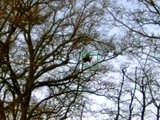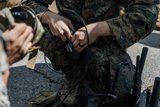EID to unveil new vehicle communication system at DSEI
The Portuguese company’s naval communications system is in service across more than a dozen countries. It has turned to its home nation for support in developing a new vehicle based C2 system.
On 23 November 2009, a space-tolerant router designed by Cisco streaks into orbit aboard a satellite owned by Intelsat Ltd. The router is currently part of a technology demonstration for the US Department of Defense (DoD), IP Routing in Space, or IRIS. The IRIS payload was successfully powered up in orbit on 01 December 2009. Network testing began on 17 December 2009, with all indications that the IRIS capability is operational.
On 28 January 2010, the US DoD will start the 90 day demonstration period to determine the IRIS suitability for the US and its NATO allies. The US DoD demonstration is the capstone of a 3-year Joint Capability Technology Demonstration (JCTD). NATO, facilitated by NC3A, has been a critical partner in the IRIS programme and has participated in a preliminary assessment last spring. During this final on orbit assessment, NC3A testing will focus on technical characteristics and operational benefits of the commercial IRIS technology for future NATO operations. IRIS is different from legacy SATCOM capabilities as it enables routing of IP packets in orbit, also across satellite beams. NC3A tests will provide insight into possible benefits for NATO operations, applications and capabilities. The NATO SATCOM architecture is defined in such a way that capabilities like IRIS can easily be integrated. The IRIS capability is envisaged as a part of the NATO network-enabled capability (NNEC) supporting seamless information exchange, ideally with global coverage.
The IRIS capability is promising and could enable US and allied military forces to seamlessly and instantly communicate over the satellite IP network from any regions of the world that are covered by any of the satellite beams. Representing the next generation of space-based communications, the on-board routing capability of IRIS offers several distinct advantages over conventional satellite technology. IRIS can route data between ground users covered by different satellite beams in a single satellite hop, thus reducing transponder utilization and increase efficiency. Because the payload regenerates the received signals, the end-to-end signal performance is improved, allowing a reduction in the size of sending and receiving terminals, particularly important for mobile applications. With IRIS, users will also be able to experience a true mobile network, one that enables them to connect and communicate how, when and where they want, and that continuously adapts to their needs without reliance on a predefined, fixed infrastructure. Finally, the software of the Cisco router and onboard modem can be upgraded from the ground, which increases the flexibility of the system to implement future waveform and router standards.
Source: NC3A

The Portuguese company’s naval communications system is in service across more than a dozen countries. It has turned to its home nation for support in developing a new vehicle based C2 system.

The Vision4ce Deep Embedded Feature Tracking (DEFT) technology software is designed to process video and images by blending traditional computer vision with artificial intelligence (AI) algorithms to present actionable information from complex environments.

Persistent Systems has been cleared by National Security Agency (NSA) to transmit sensitive data on commercial networks. The devices are added to the NSA’s Commercial Solutions for Classified (CSfC) component list which also includes other companies’ products providing the same security.

The release of the UK’s Strategic Defence Review (SDR) has been long promised as mid-year. It is possible it could be as early as 2 June although the UK Ministry of Defence (MoD) continues to play its cards close to its chest.

Intelsat outlines how its multi-orbit SATCOM architecture is enhancing connectivity and resilience for special operations forces operating in degraded and contested environments.

Next-Generation Overhead Persistent Infrared (Next-Gen OPIR) satellites are intended to provide early warning of missile launches from any location worldwide and new ground stations will result in expanded coverage of critical missile warning.